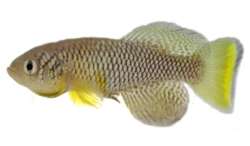Nothobranchius furzeri
| Turquoise killifish | |
|---|---|
 | |
| Male Nothobranchius furzeri GRZ (from Gonarezhou National Park) | |
| Scientific classification | |
| Kingdom: | Animalia |
| Phylum: | Chordata |
| Class: | Actinopterygii |
| Order: | Cyprinodontiformes |
| Family: | Aplocheilidae |
| Genus: | Nothobranchius |
| Species: | N. furzeri |
| Binomial name | |
| Nothobranchius furzeri R. A. Jubb, 1971 | |
Nothobranchius furzeri, the turquoise killifish, is a species of aplocheilid fish native to Africa where it is only known from Zimbabwe and Mozambique.[2] This annual fish inhabits ephemeral pools in semi-arid areas with scarce and erratic precipitations and have adapted to the routine drying of their environment by evolving desiccation-resistant eggs that can remain dormant in the dry mud for one and maybe more years by entering into diapause. Due to very short duration of the rain season, the natural lifespan of these animals is limited to a few months and their captive lifespan is likewise short, making them an attractive model system for ageing and disease research.[3] Tandem repeats comprise 21% of the species' genome, an abnormally high proportion, which has been suggested as a factor in its fast ageing.[4] The species has the fastest known sexual maturity among vertebrates, going from hatchling to an adult ready to breed in only 14 days.[5][6]
This species can reach a length of 6.5 centimetres (2.6 in) total length.[2]
The namesake of the fish is derived from the discoverer Richard E. Furzer of Rhodesia.
References
- ↑ Bills, R., Engelbrecht, J. & Marshall, B.E. 2007. Nothobranchius furzeri. In: IUCN 2013. IUCN Red List of Threatened Species. Version 2013.2. www.iucnredlist.org. Downloaded on 12 April 2014.
- 1 2 Froese, Rainer and Pauly, Daniel, eds. (2014). "Nothobranchius furzeri" in FishBase. February 2014 version.
- ↑ Harel, I.; Benayoun, B. R. N. A.; Machado, B.; Singh, P. P.; Hu, C. K.; Pech, M. F.; Valenzano, D. R.; Zhang, E.; Sharp, S. C.; Artandi, S. E.; Brunet, A. (2015). "A Platform for Rapid Exploration of Aging and Diseases in a Naturally Short-Lived Vertebrate". Cell. 160 (5): 1013–26. doi:10.1016/j.cell.2015.01.038. PMC 4344913. PMID 25684364.
- ↑ Treangen, T. J.; Salzberg, S. L. (2011). "Repetitive DNA and next-generation sequencing: Computational challenges and solutions". Nature Reviews Genetics. 13 (1): 36–46. doi:10.1038/nrg3117. PMC 3324860. PMID 22124482.
- ↑ Milius, Susan (2018-08-06). "This killifish can go from egg to sex in two weeks". Science News. Retrieved 2018-08-08.
- ↑ Vrtílek, Milan; Žák, Jakub; Pšenička, Martin; Reichard, Martin (August 2018). "Extremely rapid maturation of a wild African annual fish". Current Biology. 28 (15): R822–R824. doi:10.1016/j.cub.2018.06.031. ISSN 0960-9822.
External links
- NCBI taxonomy database
- NFIN - The Nothobranchius furzeri Information Network
- In Short-Lived Fish, Secrets to Aging (Carl Zimmer, New York Times)
- Nothobranchius furzeri in ageing research
- Maintenance, breeding & conservation of killifish
- Nothobranchius furzeri information
- Prachtgrundkärpflinge (German)
| Wikispecies has information related to Nothobranchius furzeri |
